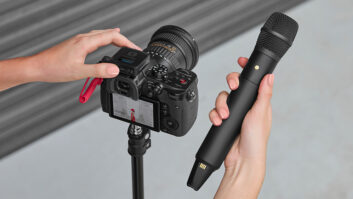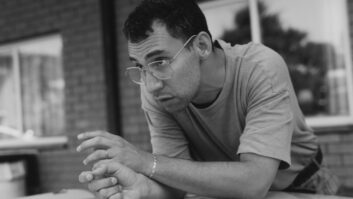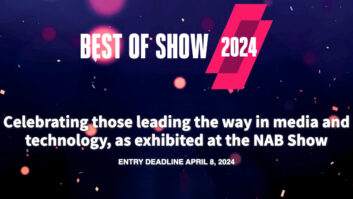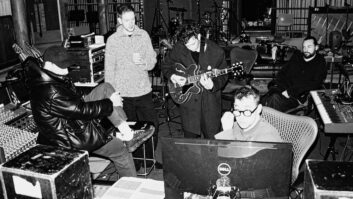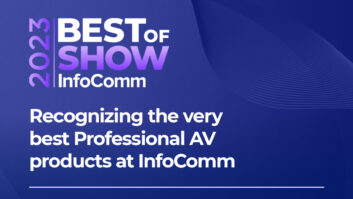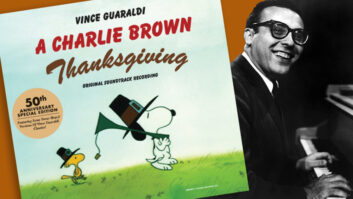Recording Harry Connick
Around the time RCA closed down Studios [1994], I worked on a Harry Connick Jr. record called She. It was an R&B record, and it was a lot of fun because we took over an old AM radio station on the top floor of the Maison Blanche building on Canal Street [in New Orleans]. The radio station had basically been moth-balled for years and years, and we cleaned it out and boarded up the windows to try to get rid of street noise. We moved gear in there. And this was before Pro Tools, so we moved a Sony 3348 tape machine up there, and a console and mics and mic pre’s, and we basically built a studio. It was this old AM radio station with all these different booths, where you’d have a sound effects guy, and every booth had a different quality to it. One was all wood, one was all tile and that kind of white board with holes in it like they had in Motown studios, and [the different booths were used] for different purposes.
This was just a temporary setup for that record, and when the record was done we packed it all up, and Showco took their gear away, and everything else went back to all the rental places, and we went back to New York and mixed it at Sony Studios.
The next record I got to do with Harry was To See You. We did that one at Capital Studios in L.A. That was 1997. I was in heaven. Historic Capital Studios, their great mic locker, Nat Cole’s piano, L.A. string players, excellent technical staff and the fantastic live echo chambers that I was prohibited from using! For that record, Harry and producer Tracey Freeman, who’s produced almost all of Harry’s records, wanted only natural room ambience, no digital reverb nor chambers. They wanted to hear the rosin on the bows, so whatever “reverb” you hear, and there is not much there, is what we captured with the M50 Decca Tree and M50 wide outs. At the close of the first day of tracking, after Harry left the studio, I patched into echo chamber number four (Sinatra’s chamber). I just had to hear those chambers—beautiful, like Sinatra’s Only the Lonely. The funny thing was, as Tracey and I were bathing in the sound of the orchestra, which was now swimming in the reverb of the echo chambers, Harry, who had forgotten his camera, returned, and said, “What’s that? I thought we agreed, no reverb!” I said, “Harry, I’m at Capital Studios, I had to just hear the chambers!” He laughed, and said “Okay, but don’t get used to it!” Those chambers are magical!
To See You was recorded all live; strings with big band, complete takes—some of Harry’s vocals were with the band while he sat at the piano and conducted at the same time. Almost every overdubbed vocal was recorded as a full pass, not comp’d nor punched. This was how he wanted to do that record because, in essence, it’s a jazz record. Yes, it’s a vocal record, with full orchestral and band arrangements, but there was a lot of space for improvisation. I’ve heard a lot of heavy Jazz musicians (like Wynton Marsalis) call it a masterpiece. I’d have to agree. We mixed it at Sony Music Studios [New York City], Studio B.
Pixar Staff Becomes the Audience in “Presto”
There’s a short film that accompanied the theatrical release of Wall-E called “Presto.” It’s about a little bunny who’s the partner of a magician, and it takes place in an old-time theater. I got to record the music, the audience and all the vocalizations. I say vocalizations not dialog because we’ve never used straight dialog in any of our short films.
At Pixar, we have a system of criticism we call “plus-ing.” The culture is such that anyone is allowed to make suggestions to anyone without fear of being humiliated or fired, and the way you do it is not through negative criticism, but by saying, “That’s good, what do you think of this?” So one of the “plus-es” I added to the making of “Presto” was my suggestion to the director, Doug Sweetland, that we record actual audience responses and that he would direct the particular response for each reaction. It was his feeling that the audience was another character, so using canned applause seemed a little weak to him. So he let one of his editors, Kevin Rose Williams, and myself organize the proceedings. We secured our theater, which holds about 250 people during lunchtime, we got signed waivers from all the employee-attendees. I put together a Pro Tools system, rolled in mic pre’s, five M50s for a Decca Tree and wide-outs, two B&K 4011s, a pair of Schoeps MK2s and “George,” our Neumann binaural head, who sat in the audience. Eventually, a 5.1 mixdown was sent to E.J. Holowicki, the film’s sound designer, and eventually off to the final mix at Skywalker.
For the score, we went to the scoring stage at Skywalker. Doug Sweetland perceived this film as a kind of an homage to the old Warner Bros. cartoons. The composer, Scott Stafford, relayed to me that he thought it would be neat to have that kind of “old-time” sound when it started—kind of small and mono—and then it should open up to sound big and modern. So what I did to “plus” their vision was to double up everything with old ribbon mics, vintage tube mics and modern condensers. Then we mixed it both ways—with the ribbon mics in mono, smaller panning, and then panning out to the modern microphones—and we mixed every cue as both a modern 7.1 and 5.1 mixdown to almost straight mono, with the old ribbon mics. Then the music editor (Marc Wilshire) was able to mix and match the proper mix that correlated best to the picture.
When Good Voice-Over Sessions Go Bad
Generally, I deliver raw audio for our projects as clean and as unadulterated as possible. I try to make sure that whenever we do a remote recording—say we need to record in New York and I can’t be there—that I’m tied in over an ISDN line, I’m listening to try to make sure it sounds good and it’s in about the same space. We make sure the person has about the same distance from the microphone, it’s not distorted, and normally if that’s happening, either the director or the producer is in the room with me, or in our record booth, and they’ll be watching and directing over a video conference line. I’m almost always in on the session, and there will almost always be somebody here with me—the editor, the producer, script supervisor—so even if I’m not recording the stuff, I’m monitoring it to make sure it’s okay.
However, there have been times when I was on another job and I didn’t do that and things went awry. There was one disaster we had in Chicago on a session for Toy Story 3 where an engineer actually had the microphone backward, believe it or not. The only people there was the director and the script assistant editor and the script supervisor, and they didn’t know [why it sounded wrong]. They kept saying to the engineer, “It doesn’t sound good, it sounds distorted, what’s wrong?” And he said, “Oh, don’t worry I have the [TLM 170] scream mic.” The director kept voicing his concern, but the engineer was saying, “It’s fine, it sounds fine in here.”
We got the stuff back, and we said, “It sounds awful. What the heck went on?” But we said, “Well, we can at least use the scream mic, right? Because the 87 is all distorted.”
Then I put up the TLM 170 track and listened, and I said, “Wait a minute, it sounds like he’s talking to the back of the TLM.” And I said to the assistant editor, “Do you have the videotape? Can I look at that?” And upon looking at the first frame of this video, I see that the TLM is pointing toward the camera.”
